BMW Z8 CONVERTIBLE 2002 Owners Manual
Manufacturer: BMW, Model Year: 2002, Model line: Z8 CONVERTIBLE, Model: BMW Z8 CONVERTIBLE 2002Pages: 174, PDF Size: 2.37 MB
Page 111 of 174
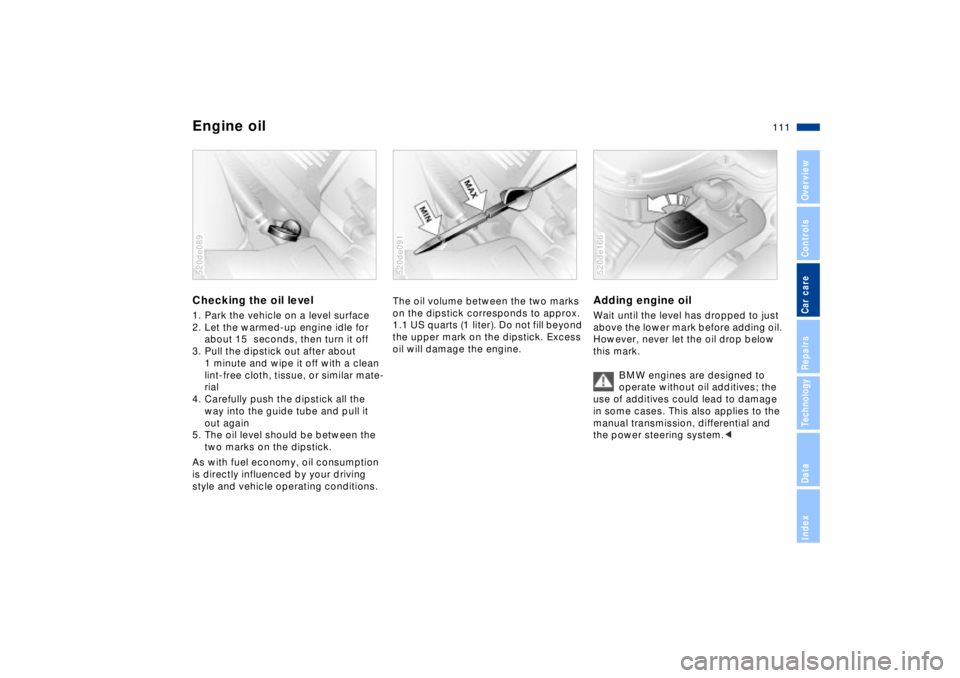
111n
IndexDataTechnologyRepairsCar careControlsOverview
Engine oilChecking the oil level 1. Park the vehicle on a level surface
2. Let the warmed-up engine idle for
about 15 seconds, then turn it off
3. Pull the dipstick out after about
1 minute and wipe it off with a clean
lint-free cloth, tissue, or similar mate-
rial
4. Carefully push the dipstick all the
way into the guide tube and pull it
out again
5. The oil level should be between the
two marks on the dipstick.
As with fuel economy, oil consumption
is directly influenced by your driving
style and vehicle operating conditions.520de089
The oil volume between the two marks
on the dipstick corresponds to approx.
1.1 US quarts (1 liter). Do not fill beyond
the upper mark on the dipstick. Excess
oil will damage the engine.520de091
Adding engine oil Wait until the level has dropped to just
above the lower mark before adding oil.
However, never let the oil drop below
this mark.
BMW engines are designed to
operate without oil additives; the
use of additives could lead to damage
in some cases. This also applies to the
manual transmission, differential and
the power steering system.<520de166
Page 112 of 174
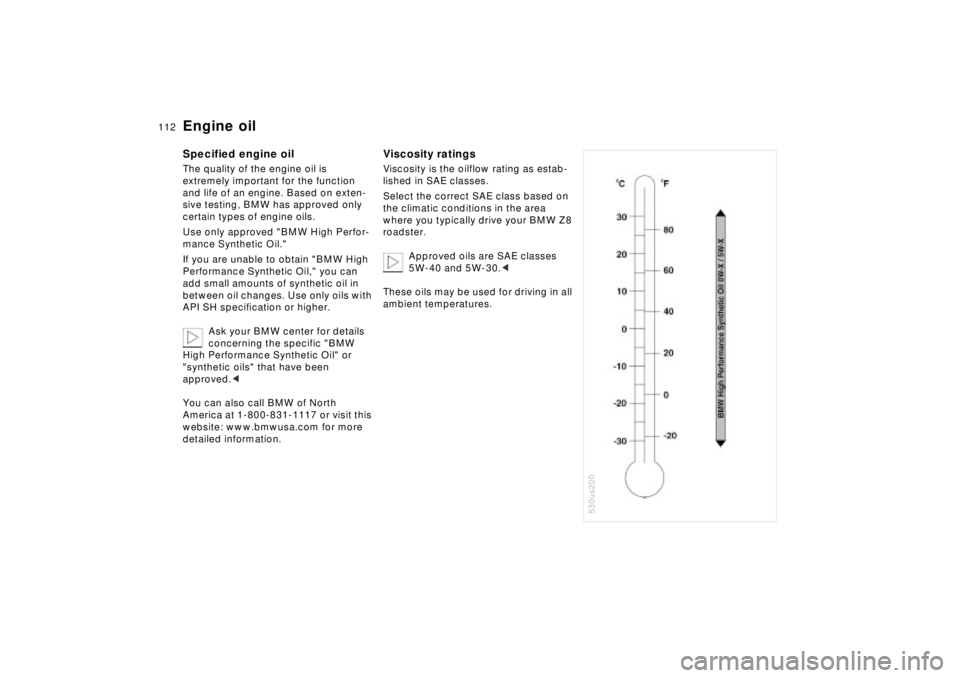
112n
Engine oil Specified engine oilThe quality of the engine oil is
extremely important for the function
and life of an engine. Based on exten-
sive testing, BMW has approved only
certain types of engine oils.
Use only approved "BMW High Perfor-
mance Synthetic Oil."
If you are unable to obtain "BMW High
Performance Synthetic Oil," you can
add small amounts of synthetic oil in
between oil changes. Use only oils with
API SH specification or higher.
Ask your BMW center for details
concerning the specific "BMW
High Performance Synthetic Oil" or
"synthetic oils" that have been
approved.<
You can also call BMW of North
America at 1-800-831-1117 or visit this
website: www.bmwusa.com for more
detailed information.
Viscosity ratings Viscosity is the oilflow rating as estab-
lished in SAE classes.
Select the correct SAE class based on
the climatic conditions in the area
where you typically drive your BMW Z8
roadster.
Approved oils are SAE classes
5W-40 and 5W-30.<
These oils may be used for driving in all
ambient temperatures.
530us200
Page 113 of 174
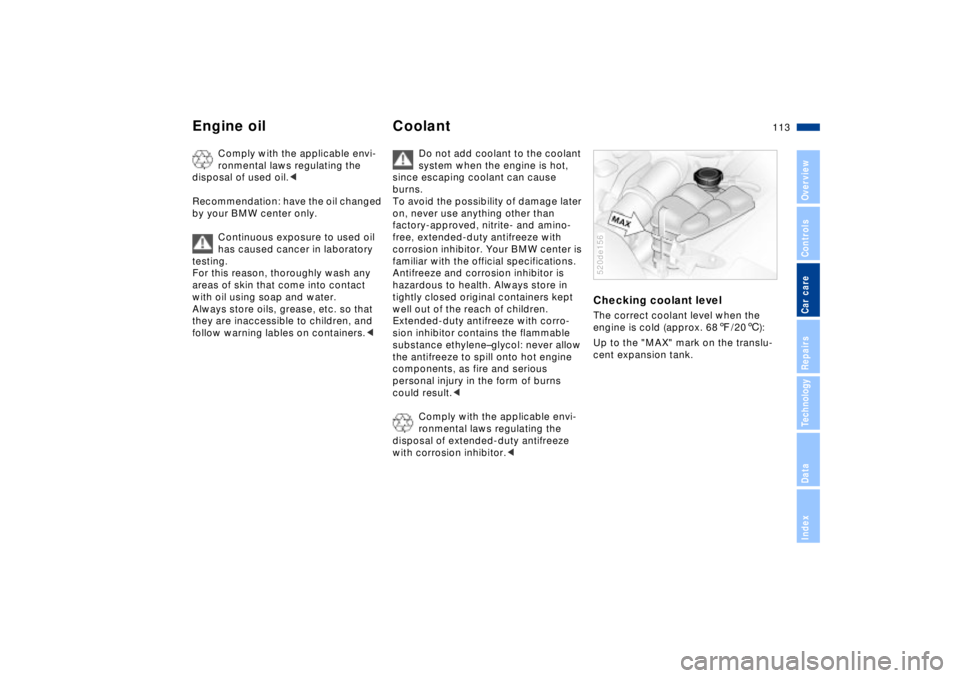
113n
IndexDataTechnologyRepairsCar careControlsOverview
Engine oil Coolant
Comply with the applicable envi-
ronmental laws regulating the
disposal of used oil.<
Recommendation: have the oil changed
by your BMW center only.
Continuous exposure to used oil
has caused cancer in laboratory
testing.
For this reason, thoroughly wash any
areas of skin that come into contact
with oil using soap and water.
Always store oils, grease, etc. so that
they are inaccessible to children, and
follow warning lables on containers.<
Do not add coolant to the coolant
system when the engine is hot,
since escaping coolant can cause
burns.
To avoid the possibility of damage later
on, never use anything other than
factory-approved, nitrite- and amino-
free, extended-duty antifreeze with
corrosion inhibitor. Your BMW center is
familiar with the official specifications.
Antifreeze and corrosion inhibitor is
hazardous to health. Always store in
tightly closed original containers kept
well out of the reach of children.
Extended-duty antifreeze with corro-
sion inhibitor contains the flammable
substance ethyleneÐglycol: never allow
the antifreeze to spill onto hot engine
components, as fire and serious
personal injury in the form of burns
could result.<
Comply with the applicable envi-
ronmental laws regulating the
disposal of extended-duty antifreeze
with corrosion inhibitor.<
Checking coolant levelThe correct coolant level when the
engine is cold (approx. 687/206):
Up to the "MAX" mark on the translu-
cent expansion tank.520de156
Page 114 of 174
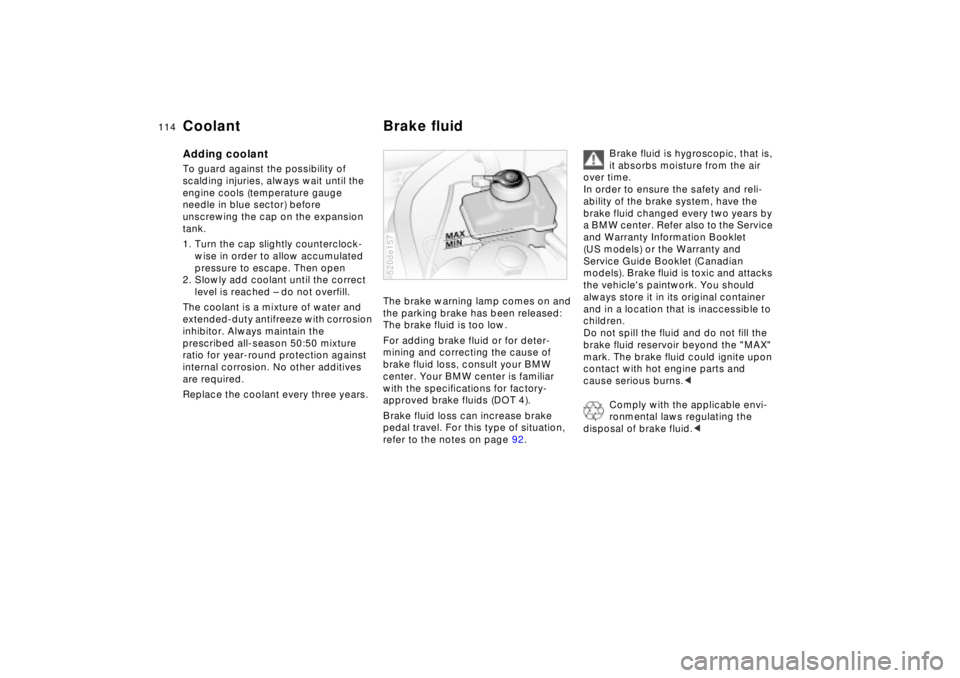
114n
Coolant Brake fluidAdding coolant To guard against the possibility of
scalding injuries, always wait until the
engine cools (temperature gauge
needle in blue sector) before
unscrewing the cap on the expansion
tank.
1. Turn the cap slightly counterclock-
wise in order to allow accumulated
pressure to escape. Then open
2. Slowly add coolant until the correct
level is reached Ð do not overfill.
The coolant is a mixture of water and
extended-duty antifreeze with corrosion
inhibitor. Always maintain the
prescribed all-season 50:50 mixture
ratio for year-round protection against
internal corrosion. No other additives
are required.
Replace the coolant every three years.The brake warning lamp comes on and
the parking brake has been released:
The brake fluid is too low.
For adding brake fluid or for deter-
mining and correcting the cause of
brake fluid loss, consult your BMW
center. Your BMW center is familiar
with the specifications for factory-
approved brake fluids (DOT 4).
Brake fluid loss can increase brake
pedal travel. For this type of situation,
refer to the notes on page 92.
520de157
Brake fluid is hygroscopic, that is,
it absorbs moisture from the air
over time.
In order to ensure the safety and reli-
ability of the brake system, have the
brake fluid changed every two years by
a BMW center. Refer also to the Service
and Warranty Information Booklet
(US models) or the Warranty and
Service Guide Booklet (Canadian
models). Brake fluid is toxic and attacks
the vehicle's paintwork. You should
always store it in its original container
and in a location that is inaccessible to
children.
Do not spill the fluid and do not fill the
brake fluid reservoir beyond the "MAX"
mark. The brake fluid could ignite upon
contact with hot engine parts and
cause serious burns.<
Comply with the applicable envi-
ronmental laws regulating the
disposal of brake fluid.<
Page 115 of 174
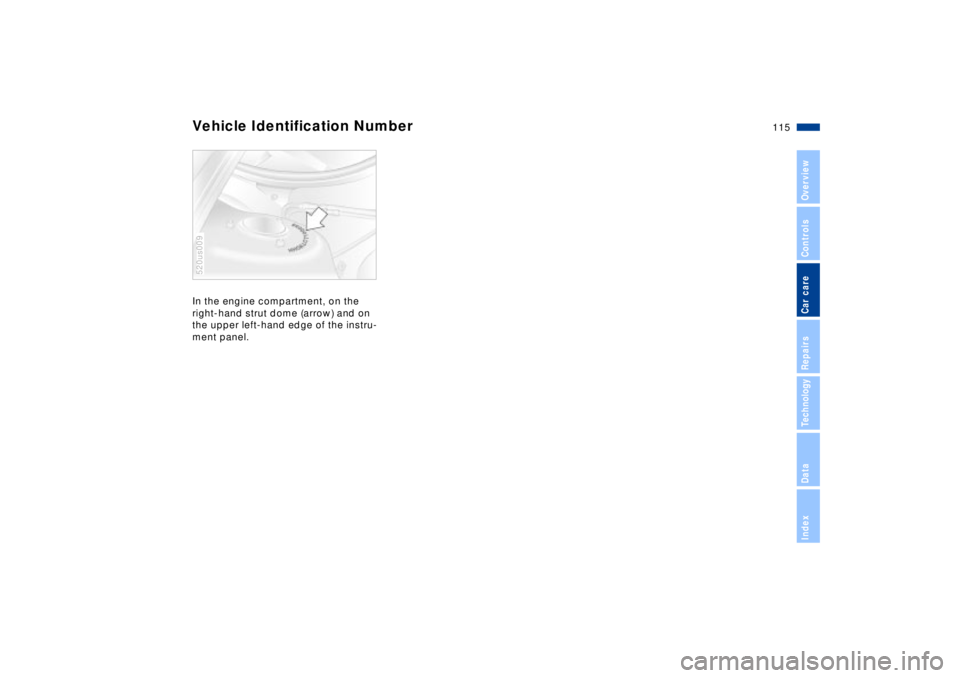
115n
IndexDataTechnologyRepairsCar careControlsOverview
Vehicle Identification NumberIn the engine compartment, on the
right-hand strut dome (arrow) and on
the upper left-hand edge of the instru-
ment panel.520us009
Page 116 of 174
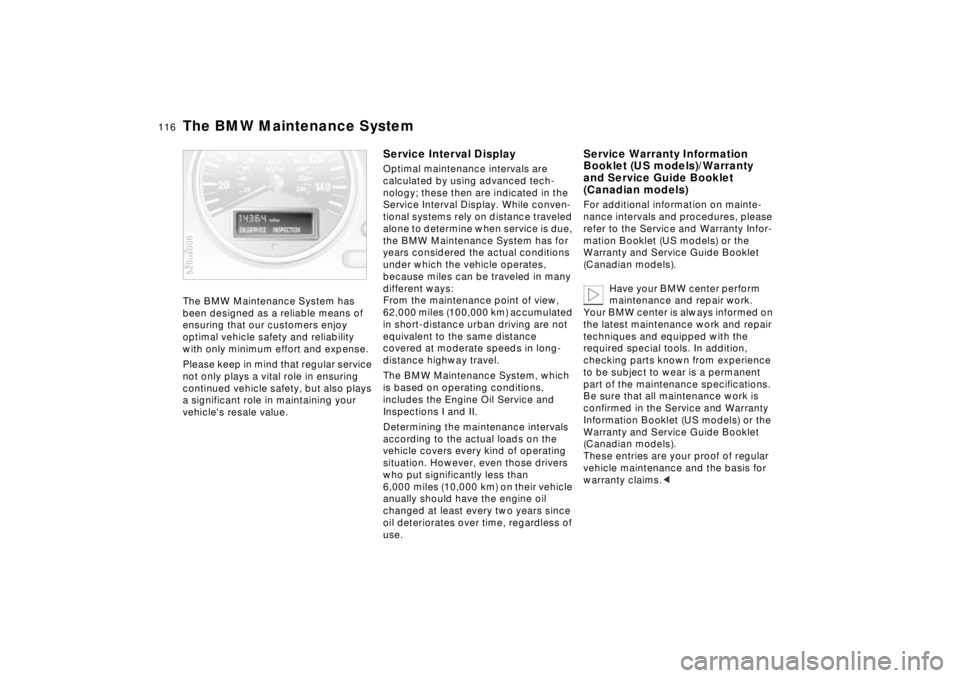
116n
The BMW Maintenance System has
been designed as a reliable means of
ensuring that our customers enjoy
optimal vehicle safety and reliability
with only minimum effort and expense.
Please keep in mind that regular service
not only plays a vital role in ensuring
continued vehicle safety, but also plays
a significant role in maintaining your
vehicle's resale value.
520us006
Service Interval DisplayOptimal maintenance intervals are
calculated by using advanced tech-
nology; these then are indicated in the
Service Interval Display. While conven-
tional systems rely on distance traveled
alone to determine when service is due,
the BMW Maintenance System has for
years considered the actual conditions
under which the vehicle operates,
because miles can be traveled in many
different ways:
From the maintenance point of view,
62,000 miles (100,000 km) accumulated
in short-distance urban driving are not
equivalent to the same distance
covered at moderate speeds in long-
distance highway travel.
The BMW Maintenance System, which
is based on operating conditions,
includes the Engine Oil Service and
Inspections I and II.
Determining the maintenance intervals
according to the actual loads on the
vehicle covers every kind of operating
situation. However, even those drivers
who put significantly less than
6,000 miles (10,000 km) on their vehicle
anually should have the engine oil
changed at least every two years since
oil deteriorates over time, regardless of
use.
Service Warranty Information
Booklet (US models)/Warranty
and Service Guide Booklet
(Canadian models)For additional information on mainte-
nance intervals and procedures, please
refer to the Service and Warranty Infor-
mation Booklet (US models) or the
Warranty and Service Guide Booklet
(Canadian models).
Have your BMW center perform
maintenance and repair work.
Your BMW center is always informed on
the latest maintenance work and repair
techniques and equipped with the
required special tools. In addition,
checking parts known from experience
to be subject to wear is a permanent
part of the maintenance specifications.
Be sure that all maintenance work is
confirmed in the Service and Warranty
Information Booklet (US models) or the
Warranty and Service Guide Booklet
(Canadian models).
These entries are your proof of regular
vehicle maintenance and the basis for
warranty claims.<
The BMW Maintenance System
Page 117 of 174

117n
IndexDataTechnologyRepairsCar careControlsOverview
Washing your vehicle You can have your new BMW washed
in an automatic car wash. Car-wash
systems that do not employ brushes
are preferable.
Wipe away tough dirt and loosen and
remove dead insects before washing
the vehicle.
In order to avoid spots, do not wash the
vehicle when the hood is warm, or
during or immediately after exposure to
strong sunlight.
In order to protect your convertible top,
do not use washing programs featuring
wax application on your vehicle. The
small amount of beading wax always
used in automatic car washes will not
harm the convertible top.
When using an automatic car wash, be
sure that
>the car-wash system is suited for the
dimensions of your vehicle
>no damage will occur on vehicles
with attached body accessories (such
as spoilers or antennas). Consult the
car-wash operator if necessary>the wheels and tires of your vehicle
cannot be damaged by the convey-
ance devices of the car-wash system
>the vehicle is cleaned with minimum
brush pressure, and that ample water
is available for washing and rinsing.
Parts of the vehicle which are inacces-
sible to the automatic washer Ð such as
door sills, door and hood edges, etc. Ð
should be cleaned by hand.
In the winter months, it is especially
important to ensure that the vehicle is
washed on a regular basis. Large quan-
tities of dirt and road salt are difficult to
remove, and they also cause damage to
the vehicle.
If spray wands or high-pressure
washers are used, be sure to
maintain an adequate distance between
the spray source and the vehicle's
surface. Inadequate distance and
excessive pressure can damage or
weaken the finish, making it more
susceptible to further damage. In addi-
tion, moisture could penetrate to
vehicle components, leading to long-
term damage.<
When cleaning the headlamps,
please observe the following:
>Do not clean by wiping with a dry
cloth. Never use abrasives or strong
solvents to clean the covers
>Remove dirt and contamination (such
as insects) by soaking with BMW Car
Shampoo and then rinsing with plenty
of water
>Always use a deicer spray to remove
accumulated ice and snow Ð never
use a scraper.<
After washing the vehicle, apply
the brakes briefly to dry them.
Braking efficiency might otherwise be
reduced by the moisture and the brake
rotors could also be corroded.<
Caring for your vehicle
Page 118 of 174

118n
Caring for your vehicleCleaning and care of the
convertible topThe appearance and life of the convert-
ible top are highly dependent on its
proper care and operation. You should
pay particular attention to the following
instructions if your vehicle has a light-
colored top.
Protect the vehicle from exposure to
intense sunlight whenever possible by
parking it in the shade. This will help to
prevent the paint, rubber and fabric-
covered parts from being attacked.
Never fold up the convertible top and
store it in the convertible top compart-
ment when it is wet, dirty or frozen, as
mildew stains and chafe spots may
result.
To prevent the formation of a crease in
the rear window and to avoid mildew
stains, do not leave the top folded in
the convertible top compartment for
long periods.
If the vehicle will be parked for lengthy
periods in an enclosed space, be sure
that the convertible top is dry and that
there is adequate ventilation.Clean off bird droppings immediately,
since they attack the convertible top
and cause the rubber seals to swell due
to their caustic characteristics.
Besides water, treat rubber seals only
with talcum powder, rubber-care prod-
ucts or silicone spray, particularly when
they feel dry or tend to stick.
Eliminate noises such as squeaks with
lubricant spray.
Never use sharp-edged objects to
clean the rear window of snow or ice. If
using a deicer spray, make sure that
none of the spray comes into contact
with the convertible top. Because of the
risk of damage and discoloration, do
not apply adhesive tape, stickers, or
similar materials to the window or cover
with plastic film.Dents and discoloration may show up
on the convertible top because of
improper care, cleaning or as the result
of excessive usage. The convertible top
and its seams may also develop leaks.
These problems are not covered by the
warranty. For repairs, please consult
your BMW center.
Special wash for the topRespond to more extensive dirt, which
is especially visible on light-colored top
materials, by cleaning the top with the
BMW Convertible Cleaning Set. Please
proceed as follows:
Spray the convertible top with the
cleaning agent and then rub with a well-
dampened sponge using circular
motions until a foam develops. Then
you can finish washing the vehicle in an
automatic car wash. After three to five
washings the convertible top should be
treated with a special impregnating
spray. Please follow the instructions on
the spray can.
Page 119 of 174

119n
IndexDataTechnologyRepairsCar careControlsOverview
Caring for your vehicle
To remove stains from the
convertible top, use only BMW-
approved cleaning agents. Do not use
spot removers, paint thinners, solvents,
gasoline or similar substances for
removing stains; these agents destroy
the rubber seals, which in turn leads to
leaks.
A full range of car-care products is
available from your BMW center.<
HardtopPlease observe and follow the instruc-
tions for caring for your vehicle starting
on page 117.
Exterior finish Your vehicle is protected by a multilayer
finish applied at the factory. Protection
against corrosion is provided by cata-
phoretic immersion priming using mate-
rials that have been specially developed
over many years of sustained research.
Regular maintenance makes an impor-
tant contribution to maintaining the
safety and value of your vehicle.
Increasing awareness of the effects of
harmful environmental factors on
vehicle finishes have led paint and
vehicle manufacturers to initiate
programs designed to further improve
the durability of their finishes. Despite
this, environmental factors that occur
locally or regionally can have negative
effects on the finish of your vehicle.
This should guide you in determining
the frequency and extent of your efforts
to maintain the vehicle finish.Road dirt, tar spots, dead insects,
animal droppings (strong alkali effect)
and even tree secretions (resins and
pollen), all contain substances capable
of causing damage to the finish of your
vehicle if allowed to remain for an
extended period of time (such as stains,
bumps, scratches and separation of the
top coat).
In industrial areas, deposits of flue dust,
lime, oily soot, precipitation containing
sulfur-dioxide (acid rain) and other envi-
ronmental pollutants will damage the
vehicle's finish unless adequate care is
provided Ð even though this is generally
limited to the outside horizontal
surfaces.
In tropical climates intense ultraviolet
radiation and high atmospheric
humidity are accompanied by tempera-
tures that can exceed 105 7 (40 6) in
the shade. Under those conditions, light
paints can reach temperatures of up to
175 7 (80 6) while darker finishes can
heat to levels as high as 250 7
(120 6).
Page 120 of 174

120n
Caring for your vehicleCaring for the vehicle finish Regular washing is a preventive
measure against long-term effects from
substances that are harmful to the
vehicle's finish, especially if you drive
your vehicle in areas with high levels of
air pollution or natural contaminants
(tree resins, pollen).
Nevertheless, you should immediately
remove especially aggressive
substances. Failure to do so can lead to
changes in the paint's chemical struc-
ture or to discoloration. Gasoline spilled
during refueling, oil, grease, brake fluid
and bird droppings should always be
cleaned up immediately.
Any contamination remaining on the
surface of the vehicle will be especially
conspicuous after washing. Use
cleaning fluid or alcohol and a clean
cloth or cotton pad to remove. Remove
tar spots with tar remover. After
cleaning, the affected areas should be
waxed to ensure continued protection.
Use the cleaning and car-care
products available at your BMW
center.<
Waxing your vehicle Protect the finish using carnauba or
synthetic-based waxes only.
The best way to determine when the
finish needs to be waxed is by noting
when water stops beading on the
surface.
You can use a glass cleaner to remove
any wax or silicone that may have been
left on the windows during waxing.
Use the cleaning and car-care
products available at your BMW
center.<
Repairing the paintYou can touch up small areas of paint
damage with a BMW spray paint or a
BMW touchup stick.
The color code of your vehicle is
provided on a tag located near the
vehicle data plate and on the first page
of the Service and Warranty Information
Booklet (US models) or the Warranty
and Service Guide Booklet (Canadian
models).
More extensive paint damage should
be repaired professionally in accor-
dance with the manufacturer's instruc-
tions. Your BMW center uses original
BMW finish materials in accordance
with approved repair procedures.